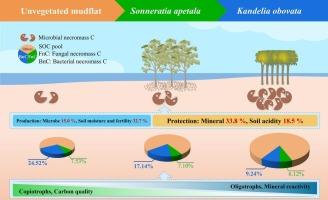红树林造林增加了微生物坏死,但减少了它们对土壤碳库的贡献
IF 7
2区 环境科学与生态学
Q1 ENVIRONMENTAL SCIENCES
引用次数: 0
摘要
尽管微生物坏死块碳(MnC)在固碳中的重要性已得到广泛认可,但红树林中微生物坏死块碳(MnC)积累的调节机制仍知之甚少。因此,本文以红树恢复示范区为研究对象,研究了红树造林后MnC的变化,以及微生物和矿物质对MnC的影响。该示范区由原生红树、外来无片海桑和无植被泥滩组成。结果表明,红树林造林后MnC明显增加。与未植被的泥滩相比,无瓣荆芥和倒蛋荆芥土壤的MnC分别从0.81 g/kg增加到1.09 g/kg和3.05 g/kg。红树林造林,特别是倒叶松人工林,也增加了细菌和真菌数量,导致活微生物生物量碳和MnC增加。MnC的积累也与非晶氧化铁呈正相关。此外,随机森林和偏最小二乘路径模型分析的结果进一步表明,矿物保护对跨国公司积累的贡献比微生物生产更显著。此外,红树林造林与细菌和真菌中k策略类群的增加之间存在有趣的联系,这降低了跨国公司对土壤碳库的贡献。总之,这是第一次从红树林微生物生产和矿物质保护的角度揭示MnC积累机制的尝试。本研究提供了对红树林固碳机制的新认识。本文章由计算机程序翻译,如有差异,请以英文原文为准。

Mangrove afforestation increases microbial necromass but reduces their contribution to soil carbon pool
Despite the widely acknowledged importance of microbial necromass carbon (MnC) in carbon sequestration, the mechanisms regulating MnC accumulation in mangroves remain poorly understood. Therefore, a mangrove rehabilitation demonstration zone, comprising native Kandelia obovata, exotic Sonneratia apetala, and unvegetated mudflat, was employed to investigate the variations in MnC after mangrove afforestation, as well as the underlying roles played by microorganisms and minerals. The results showed an obvious increase in MnC after mangrove afforestation. Compared with unvegetated mudflat, MnC increased from 0.81 g/kg to 1.09 g/kg and 3.05 g/kg in S. apetala and K. obovata soils, respectively. Mangrove afforestation, especially the plantation of K. obovata, also boosted bacterial and fungal quantities, leading to an increase in living microbial biomass carbon and MnC. The accumulation of MnC was also found to be positively correlated with amorphous iron oxides. Moreover, the findings from random forest and partial least squares path modeling analyses further suggested that mineral protection had a more significant contribution to MnC accumulation than microbial production. In addition, an interesting linkage was observed between mangrove afforestation and increased the K-strategy taxa both in bacteria and fungi, which diminished the contribution of MnC to soil carbon pool. In conclusion, this is the first attempt to reveal the mechanisms involved in MnC accumulation from the perspective of microbial production and mineral protection in mangroves. This study offers novel understandings of the mechanisms of carbon sequestration in mangroves.
求助全文
通过发布文献求助,成功后即可免费获取论文全文。
去求助
来源期刊

Ecological Indicators
环境科学-环境科学
CiteScore
11.80
自引率
8.70%
发文量
1163
审稿时长
78 days
期刊介绍:
The ultimate aim of Ecological Indicators is to integrate the monitoring and assessment of ecological and environmental indicators with management practices. The journal provides a forum for the discussion of the applied scientific development and review of traditional indicator approaches as well as for theoretical, modelling and quantitative applications such as index development. Research into the following areas will be published.
• All aspects of ecological and environmental indicators and indices.
• New indicators, and new approaches and methods for indicator development, testing and use.
• Development and modelling of indices, e.g. application of indicator suites across multiple scales and resources.
• Analysis and research of resource, system- and scale-specific indicators.
• Methods for integration of social and other valuation metrics for the production of scientifically rigorous and politically-relevant assessments using indicator-based monitoring and assessment programs.
• How research indicators can be transformed into direct application for management purposes.
• Broader assessment objectives and methods, e.g. biodiversity, biological integrity, and sustainability, through the use of indicators.
• Resource-specific indicators such as landscape, agroecosystems, forests, wetlands, etc.
 求助内容:
求助内容: 应助结果提醒方式:
应助结果提醒方式:


